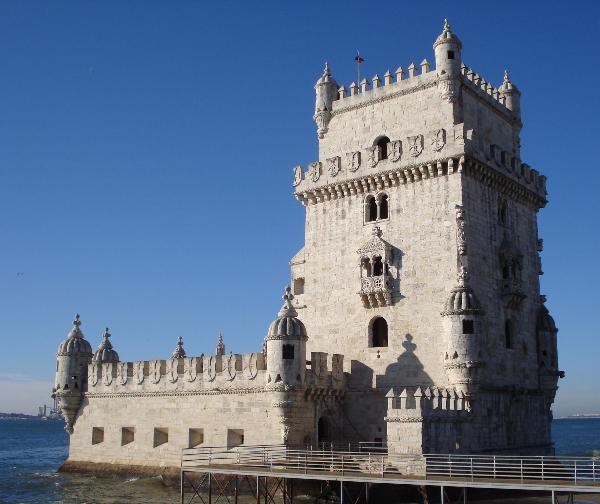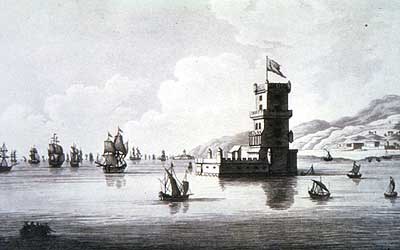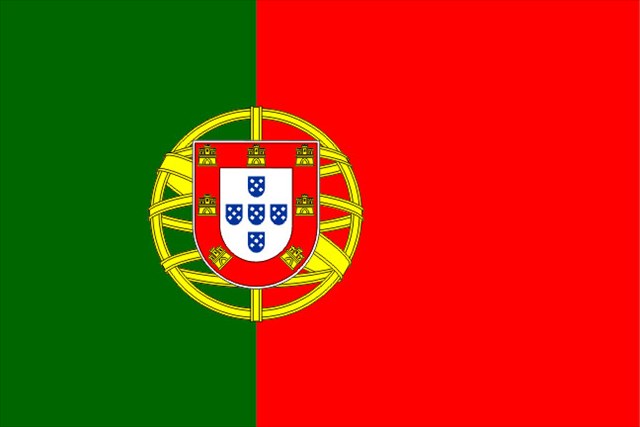
Belém Tower (in Portuguese Torre de Belém) is a fortified tower located in the Belém district of Lisbon. It was built in the early 16th century in the Portuguese late Gothic style, the Manueline, to commemorate Vasco da Gama's expedition and it stands as one of the symbols of the city, a memorial to the Portuguese power during the Age of the Great Discoveries when Lisbon was the capital of an immense maritime empire. In 1983, it was classified as a UNESCO World Heritage Site.

History
During the Age of the Great Discoveries, Lisbon grew in importance, as it became a cosmopolitan city and a melting pot of different cultures, peoples and new ideas. Portugal's naval strategy in the 16th century and the sea routes of the time made Lisbon a natural port of call for those engaged in international maritime trade.
In order to enhance Lisbon's defence, King D. João II (1455-1495) drew up a plan that consisted of forming a three-fortress-defence on the Tagus's estuary. It formed a triangle and on each angle, a fortress was constructed: Cascais's fortress on the right bank, S. Sebastião da Caparica (also called the Old Tower) on the left bank and Belém Tower in the water, which was completed by King D. Manuel I (1469-1521), who succeeded the former after his death.
This third fortress, Belém Tower, was built in memory of the patron saint of Lisbon, St. Vincent, on the former mooring place of a large ship, the Grande Nau.
The Tower was constructed between 1515 and 1521 by military architect Francisco de Arruda, who had already built several fortresses in Portuguese possessions in Morocco. Originally, the Tower stood on a little island on the right side of the Tagus River, surrounded by water. Opposite the beach at Restelo, with the progressive southward creeping of the shore over the years, it is now practically moored to the bank itself.

In 1580, when Lisbon was invaded by Spanish troops in the course of a struggle for the Portuguese throne, the Tower fought and surrendered to the Duke of Alba. With the passage of time and with the construction of more modern and efficient fortresses, the Belém Tower lost its main purpose - the defence of the Tagus harbour. During the centuries that followed it acquired new functions: prison (with the underground cellars regularly flooding), custom house, telegraph office and even a lighthouse.
It was declared a National Monument in 1910.
Arts and Architecture
The Belém Tower can be divided into two parts, the bastion, with the shape of an irregular hexagon, and the five-story tower itself, located on the north side of bastion. The whole ensemble looks like the bow of a caravel.
The Belém Tower is considered one of the main works of the Portuguese late gothic, the Manueline style. Indeed, the tower is decorated with several typical Manueline motifs like the armillary sphere (the symbol of King D. Manuel I), the cross of the Order of Christ, twisted ropes, elaborate rib vaulting and other features. However, some of the decoration dates from the renovation of the 1840s, like the shields with the cross of the military Order of Christ, that decorate the crenellations of the walls, and the decoration of the small cloister of the bastion. The part of the tower facing the river displays the richest decorations.
The bastion has a vaulted chamber (the casemate), with openings in the 3.5 m-thick walls for the cannons. The bastion platform could also be used for the emplacement of light-calibre guns. This was the first Portuguese fortification with a two-level gun emplacement and it marks a new development in military architecture.
The entrance to the Tower is done through a portal decorated with many Manueline motifs, including King D. Manuel I's badge of honour (an armillary sphere). The whole tower is also decorated with stone twisted ropes, which even tie a knot at the north façade of the building. The upper corners of the tower walls have statues of St Vincent and St Michael, as well as many fine windows with arches. The renaissance-style covered loggia, running the full length of the south side of the first floor of the tower, is particularly delicate. The many shields that decorate the merlons are neo-manueline.

The tower itself, 35 metres high, has four storeys and a terrace that offers wonderful views of the surrounding landscape. Of the tower floors, the most interesting is the chapel of the fourth floor, with a magnificent Manueline rib vault decorated with the armillary sphere and the cross of the military Order of Christ, who participated in many Portuguese conquests.
Visits
Timetable:
October to April from 10.00 am to 5.00 pm; May to September from 10.00 am to 6.30 pm
last ticket 30 minutes before closing
Days closed:
Mondays and the following public holidays: 1st January; Easter Sunday; 1st May and 25th December
Tickets:
- Standard: € 5
- 65 and older and disabled by showing a suitable card: € 2,5
- Youth Card: € 2
- Family Card (parents with two or more children under 18): 50% discount upon the ticket price for the children if accompanied by one of their parents
Free Admission:
- Children till 14 years old
- Sundays and Holidays till 2.00 pm
- For individual teachers and students (maximum 15 visitors) or teachers and students on study visit, subject to previous booking and a suitable document from school or college
- Holders of Lisboa Card
==========================================================
The Cache
At the given coordinates, observe carefully and obtain the following information:
- The number of sentry posts on the bastion (A)
- The number of cannon openings on the walls of the bastion (B)
- The number of steps in the stairs that lead to the main entrance of the tower (do not consider the final platform) (C)
- The number of armillary spheres on the south face of the tower (D)
- The number of arches on the renaissance-style covered loggia on the south face of the tower (E)
- The number of shields (including the "half shields") that decorate the merlons on the north face of the tower (F)
Now perform the following calculations:
U = A-1
V = B-16
W = C-9
X = D+7
Y = E+1
Z = F-4
You can find the cache at N38º 41.UVW; W009º 12.XYZ
Recommendations:
Please be very stealth when searching for this cache.
The cache has no writing material, so please bring your own one.
Do not publish ANY logs or photos that could lead to the cache location.

A Torre de Belém é um dos monumentos mais expressivos da cidade de Lisboa. Foi construída no início do século XVI, reflectindo influências islâmicas e orientais, que caracterizam o estilo manuelino. A sua construção marca o fim da tradição medieval das torres de menagem, ensaiando um dos primeiros baluartes para artilharia no país. Destaca-se como um dos símbolos da cidade, um memorial para o poder Português durante a Era das Grandes Descobertas, quando Lisboa era a capital de um império marítimo imenso. Em 1983 foi classificada como Património Mundial pela UNESCO.
História
Durante a era dos Descobrimentos, Lisboa cresceu em importância, tendo-se tornado uma cidade cosmopolita e um ponto de encontro de diferentes culturas, povos e novas ideias. A estratégia naval de Portugal no século XVI e as rotas marítimas da época fizeram de Lisboa um porto de chamada para todas as gentes envolvidas no comércio marítimo internacional.
Com o objectivo de melhorar a defesa de Lisboa, o rei D. João II (1455-1495) elaborou um plano que consistia na formação de um conjunto de três fortalezas no estuário do Tejo. Esse conjunto formava um triângulo, tendo sido construída uma fortificação em cada um dos vértices: a fortaleza de Cascais na margem direita, S. Sebastião da Caparica (também chamada Torre Velha) na margem esquerda e a Torre de Belém no leito do rio, esta última vindo a ser terminada no reinado de D . Manuel I (1469-1521), que sucedeu ao primeiro após a sua morte..
Esta última fortificação, a Torre de Belém, foi construída em memória do santo padroeiro de Lisboa, São Vicente, no local de ancoragem de um grande navio, a Nau Grande.
A torre foi construída entre 1515 e 1521 pelo arquitecto militar Francisco de Arruda, que entretanto já havia construído várias fortalezas em possessões portuguesas em Marrocos. Originalmente, a Torre estava situada numa pequena ilha perto da margem direita do rio Tejo, como tal rodeada de água por todos os lados. Com o avanço progressivo das areias para sul, encontra-se actualmente ligada à própria margem.
Em 1580, quando Lisboa foi invadida por tropas espanholas no decurso de um conflito pelo trono de Portugal, a Torre ripostou e acabou por se render ao duque de Alba. Com o passar do tempo e com a construção de fortalezas mais modernas e eficientes, a Torre de Belém perdeu o seu principal objectivo - a defesa do porto do Tejo. Durante os séculos que se seguiram adquiriu novas funções: prisão (com as caves subterrâneas regularmente inundadas pelas marés), alfândega, telégrafo e até mesmo um farol.
Foi declarada Monumento Nacional em 1910.
Arte e Arquitectura
A torre Belém pode ser dividida em duas partes: o bastião, com a forma de um hexágono irregular, e a torre propriamente dita de cinco andarei, localizados no lado norte bastião. Todo o conjunto faz lembrar o arco de uma caravela.
A Torre de Belém é considerada uma das principais obras do gótico Português tardio, o estilo manuelino. Esta encontra-se decorada com vários motivos manuelinos típicos tais como a esfera armilar (o símbolo do Rei D. Manuel I)ou a cruz da Ordem de Cristo. No entanto, alguma da decoração data da renovação efectuada da década de 1840, tal como os escudos com a cruz da Ordem Militar de Cristo que decoram as ameias das paredes e a decoração do pequeno claustro do bastião. A parte da torre virada para o rio exibe as mais ricas decorações.
O bastião tem uma câmara abobadada (a casamata), com aberturas de 3,5 m de espessura nas paredes para os canhões. A plataforma do bastião também poderia ter sido utilizada para a colocação de outros tipos de armas. A Torre de Belém foi a primeira fortificação Portuguesa com uma colocação de armas dispostas em dois níveis, tendo constituído um marco de desenvolvimento na arquitectura militar.
A entrada para a Torre é feita através de um portal decorado com diversos motivos manuelinos, incluindo a insígnia de honra (esfera armilar) do Rei D. Manuel I. A torre encontra-se igualmente decorada com cordas torcidas de pedra, que terminam num nó na fachada norte da estrutura. Os cantos superiores das paredes da torre têm estátuas de S. Vicente e S. Miguel, bem como muitas janelas com arcos. A loggia renascentista, que se desenvolve ao longo de todo o comprimento do lado sul do primeiro andar da torre, é particularmente delicada. Os vários escudos que decoram os ameias são neo-manuelinos.
A torre em si tem 35 metros de altura, quatro andares e um terraço que oferece uma vista fantástica sobre a paisagem circundante. Dos pisos da torre, o mais interessante é a capela do quarto andar, com uma abóbada manuelina decorada com a esfera armilar e a cruz da Ordem Militar de Cristo, que participou em muitas conquistas portuguesas.
Visitas
Horários:
Outubro a Abril das 10h às 17h30; Maio a Setembro das 10h ás 18h30
última entrada 30 minutos antes do fecho
Dias de encerramento:
Segundas-feiras e nos dias 1 de Janeiro, Domingo de Páscoa, 1 de Maio e 25 de Dezembro
Bilhetes:
- Bilhete individual: € 5
- Utentes com idade igual ou superior a 65 anos ou portadores de deficiência: € 2,5
- Cartão Jovem: € 2
- Bilhete de Família (pais com dois ou mais filhos menores de 18 anos): 50% de desconto para os filhos menores desde que acompanhados por um dos pais
Entrada livre:
- Crianças até aos 14 anos
- Domingos e Feriados até às 14h
- Professores e alunos de qualquer grau de ensino, no âmbito de visitas de estudo, desde que tenham feito marcação prévia junto dos serviços
- Portadores do Lisboa Card
==========================================================
A Cache
Nas coordenadas iniciais observe cuidadosamente e obtenha a seguinte informação:
- O número de guaritas no bastião (A)
- O número de aberturas de canhão nas paredes do bastião (B)
- O número de degraus nas escadas que conduzem à entrada principal da Torre (não contar com a plataforma final) (C)
- O número de esferas armilares na face sul da Torre (D)
- O número de arcos da loggia renascentista na face sul da Torre (E)
- O número de escudos (incluindo os "meio escudos") que decoram as ameias na face norte da Torre (F)
Agora efectue os seguintes cálculos:
U = A-1
V = B-16
W = C-9
X = D+7
Y = E+1
Z = F-4
A cache encontra-se em N38º 41.UVW; W009º 12.XYZ
Recomendações:
Por favor seja muito discreto na procura da cache.
A cache não tem material de escrita.
NÃO publique logs ou fotos que possam revelar o esconderijo da cache.